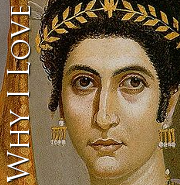Some people collect art. Or classic cars. I collect final resting places. That might sound a little morbid. Are you wondering why I’d spend any of my days on earth, exploring a Roman necropolis, sharing a picnic with the dead at Athens’ oldest cemetery, or studying the female gladiators depicted in the ruins of Ephesus?
Because a cemetery is one of the places where the action is. Where the stories are, for a writer. Where unsung history can be found—and I’m a finder. After 30 years as a nonfiction author, I’m firmly addicted to researching the deep past.
The Mediterranean lands are my special focus, but I relish travel to more faraway places, too. Invariably they have burial sites, from humble niches to elaborate monuments, where ancient ritual and superstition intersect. I look at my voyages as a privileged form of time-travel, combining mental excursions with physical journeys.
Oddly enough, this graveyard enthusiasm of mine has enriched my foreign language studies. For instance, my interest in inscriptions on stelae helped me learn Greek. (Trying to locate cemeteries also motivated me to learn how to understand Greek answers to my questions!)
During Rome’s long heyday, tombs in Rome and throughout the Empire came to resemble “billboards” in stone. From them, I’ve gained insight into countless human stories. The iconography is often literal: for instance, the busy clan of the Haterii, a family of Roman builders, put exquisitely detailed bas reliefs on their tomb, showing their architectural projects, right down to the building cranes. Butchers, bakers, shipwrights, and silversmiths proudly displayed the tools of their trades on their graves. So did doctors. Charioteers and gladiators posted won-lost records on theirs. Even humbler folks, including slaves and freedwomen, created elaborate tomb visuals.
Tomb of Haterii. Bust of man. Cast in Pushkin museum from original in Musei Vaticani, 79-80 AC. Found in 1848 near Porta Maggiore, Roma. Photo by shakko published under the Creative Commons license.
These funereal works of art must have been a comfort and source of pride to the deceased’s family. Today’s historians, archaeologists, and writers like me are equally thankful for these invaluable clues about the everyday joys and sorrows of the past.
There’s nothing solemn about many of these places. Among the earthy Greeks and Romans, certain sexual saleswomen routinely used cemeteries to post adverts for potential clients. And later, as rendezvous sites. After seeing the solid concrete “beds” of the Pompeii brothels a few years ago, I’d say that a horizontal crypt might look like an upgrade.
Hanging out in these cities of the dead, I’ve had shivery moments as well. In researching my book on science and superstition (How to Mellify a Corpse) I’ve had to delve into Greco-Roman attitudes towards death—and why they feared ghosts so much.
Here’s part of the answer: “Death rites had high priority among those still above ground. Neither Greeks nor Romans were sanguine about the prospects of a rewarding afterlife. The final launch, however, had to be done right because ghosts were easily enraged by corner cutting. Since even those of modest means were meticulously memorialized, the funerals of the great or even the quasi-great had to be spectacular.”
Cranky ghosts notwithstanding, visiting the ancient dead gives me a sense of history, a peek at the awesome sweep of centuries. Their fine and private places reveal to me how much we have in common with the men, women, and children who lived and died thousands of years before us.
____________________________________________
Vicki León’s love of travel, her fondness for foreign languages, and her craving for exotic foods and archaeology would be enough to make a satisfying life. As it happens, however, her passions have led her to become a multi-faceted writer of non-fiction for young and old. Beginning in 1989, she’s written nine well-reviewed books on women’s history that have sold over 350,000 copies and become evergreen backlist titles. The best-known: the 4-book Uppity Women in History series for Conari Press. She is also the author of the acclaimed Working IX to V. Her new book, How to Mellify a Corpse was released July 6, 2010. To know more about Vicki you can visit her website: http://vickileon.com/





Vicki, I loved your book, "Working IX to V." I think cemeteries are fascinating, too. They're are like a glimpse into the most private part of a human being's past. Immediately I begin asking questions: How did this person live? Was he happy? What were his fears? What historical events did he live through?
ReplyDeleteAnd one day, someone may walk past our own graves asking the same questions.
Thanks for the post
Great post! I have found a recent source of fascination in my own local cemetery as well (Oakwood Cemetery in Austin). The stories that the graves have to tell about life and death in my city years before I was born are amazing!
ReplyDeleteyes fantastic bopk I really enjoyed
ReplyDeleteVicki, This was so fun to read. I'm a fellow cemetery lover. There's a large Victorian cemetery in my city, which hosts tours. I definitely learned some history not in the textbooks.
ReplyDelete